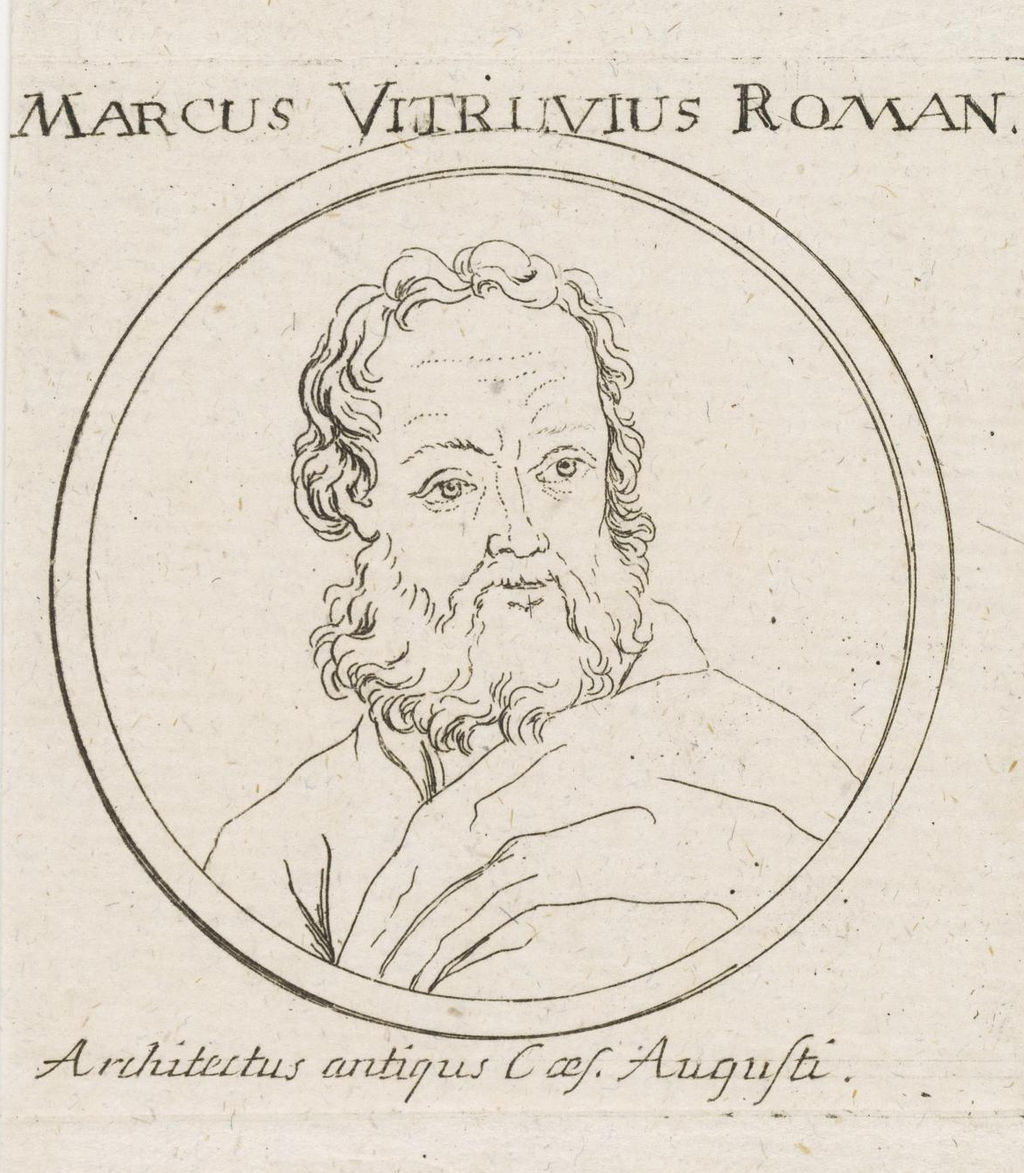Marcus Vitruvius Pollio, Architectural Origins, Architecture Article
Marcus Vitruvius Pollio : Origins of the Architect
Architecture Discussion by Ian K Whittaker
12 Jun + 21 Jan 2013
Marcus Vitruvius Pollio Origin
Article by Ian K Whittaker
Marcus Vitruvius Pollio – A possible explanation of his name and a timeline for his life
Marcus ‘uiTRuuii’ Pollio
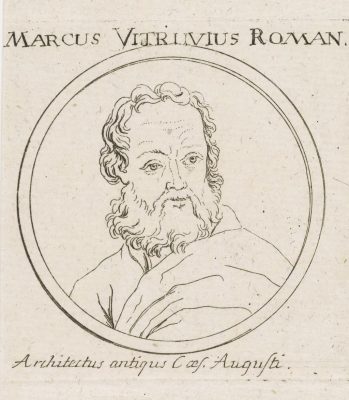
photo : Unknown authorUnknown author, Public domain, via Wikimedia Commons
Background
Architecture has its written western origins within the text of De Architectura but the author of the text, remains obscure.
An examination of the praenomen, ‘Marcus’ and cognomen, ‘Pollio’, parts of the name can indicate birth and family details as well as a potential description. However the nomen by which he is commonly referred to ‘Vitruvius’,remains obscure and so it warrants further contextual examination.
This can be achieved by examination of the manuscripts, his apparent name structure, and a timeline of his life including known historical events and people.
Examining the author of De Architectura in these contexts extends the current limited viewpoint, through interpolation, into multiple contextual interpretations.
In creating this timeline I hope that this examination can be taken further to fix the origins of the author of De Architectura and the documents that have established Western Architecture.
Oldest Manuscript
The oldest extant version of De Architectura, the Harley 2767 manuscript in the British Library, from the abbey of St. Pantaleon, Cologne,may, through interpretation, provide a translation of the actual ’Vitruvius’, as ‘uiTRuuii’. The word ‘uitruuii’ in relation to the information in De Architectura has its origins in the Oscan, Etruscan and Athenian languages. The origins of the oldest extant translation are through the text font which is Carolingian minuscule from the Holy Roman Empire and then into Germany and the Netherlands. The title follows the German Netherland latin form ‘uitruuii de architectura’ . ‘uitruuii’ in the German, Netherland language latin also links to the modern word ‘uitruil’ as ‘trade off’, ‘exchanges’.
This could be interpreted as the supposed authors middle name ‘uiTRuuii’ being not in fact a name but part of the title of the work. The title being ‘uiTRuuii De ARchitectura’. ‘Works off, exchanges of the chief builders.’
In about 95 AD Julius Sextus Frontius writes a report on The Aquaducts of Rome,
De Aquis, as part of his role as curator aquarum for the Emperor Nerva.
In Book 1. 25 of this work Frontius refers to a ‘Vitruvium Architectum’ and ‘Vitruvium et plumbarios’
This can be translated as ‘Vitruvius Architect’ and ‘Vitruvius and plumbers’
Or this can be translated as ‘Works off the chief builders’and ‘Works off the plumbers’
Or this can be translated as ‘Vitruvius writeth on the chief builders’and ‘Vitruvius writeth and plumbers’
In the 3rd Century BC Marcus Cetius Faventinus refers to “Vitruvius Polio aliique auctores”
Later editions include the name ‘Marcus’in addition to the use of ‘Vitruvius’and ‘Polio’, ‘Pollio’and ‘Pollionis’.
Consequently the name of the author keeps changing as each translation is undertaken.
Name structure of Marcus ‘Vitruvius’ Pollio
Marcus ‘uiTRuuii’Pollio’s name can be examined through the translation of his praenomen, nomen and cognomen.
The structure of De Architectura authors name can be first examined from the oldest extant manuscript, the Harley 2767, in the British Library.
Praenomen – ‘Marcus’
The Harley 2767 manuscript does not contain this name. It comes from later manuscripts.
If examined as a possible name then it can be interpreted as referring to the month of March (Martius) from the praenomen (Marcus) assigned to him.
March may also be a reference to the Marche area of Italy the location of the current commune of Fano, formerly in 9 AD the Colonia Julia Fanestris, formerly in 49-45 BC Fanum Fortunae where the author of De Architectura states he once erected and superintended a Basilica.
Nomen – ‘Vitruvius’
The Harley 2767 manuscript does not contain this name. It comes from later manuscripts.
The name Vitruvius as a nomen would comes from the Greek tradition of adding their Deme or Tribe or Genos (gens in latin) name to their personal name.
In examining the Harley 2767 manuscript however the name differs from the common given name in manuscripts of ‘Vitruvius’. It is written as ‘uiTRuuii’. Therefore before a tribal name translation is applied a meaning for ‘uiTRuuii’ needs to be established.
Nomen Vitruvius’ , ‘uiTRuuii’ – Works Off.
The first translation is to read the word ‘ uiTRuuii’ as part of the title on the Harley 2767 manuscript.
uiTRuuii DE ARchitecTURa . LiB 1.
This could be translated as ‘works off the chief builders’. Book 1.
Nomen Vitruvius’, ‘uiTRuuii’ – ‘Vl TR V VII’
The second translation proposes a military translation of the word ‘ uiTRuuii’ and an explanation for the emphasis of the ‘TR’ letters in the manuscript.
The military translation would read 6TR57
This when expanded could read.
Sixth Tribune (TR.,abb. N M [XLXDX] lesser TRIBUNE; abb. tr.; [tr. pl./tr. mil. => of the people/of the soldiers]; which may refer to his rank.) to a General of the 5th cohort of the 7th Legion the Legio VII later called Legio VII Claudia Pia Fidelis
The last part of the title ‘De Architectura’ then still reads ‘the chief builders‘, referring to the historical architects, chief builders, and to the training and use of craftsmen by the legions, the main builders in the roman era.
Another link to the alternative military form of the title originates from the references to Ballista, artillery, the engines of war in De Architectura.
Augustus had apparently previously appointed the author of De Architectura and M. (Marcus) Aurelio, Publius Minidio and Gn.(Gnaeus) Cornelio with the care of, the various engines of war or ballista. This could have taken place in 44 BC when Augustus would have taken command of the Legions.
Augustus then reconfirms this appointment in 26 BC.
The reason for the re-appointment would be the building in Rome being undertaken by Augustus at this time. The author explains this in ‘De Architectura’
‘And so with Marcus Aurelius, Publius Minidius, and Gnaeus Cornelius, I was ready to supply and repair ballistae, scorpiones, and other artillery, and I have received rewards for good service with them. After your first bestowal of these upon me, you continued to renew them on the recommendation of your sister.
Owing to this favour I need have no fear of want to the end of my life, and being thus laid under obligation I began to write this work for you, because I saw that you have built and are now building extensively, and that in future also you will take care that our public and private buildings shall be worthy to go down to posterity by the side of your other splendid achievements. I have drawn up definite rules to enable you, by observing them, to have personal knowledge of the quality both of existing buildings and of those which are yet to be constructed. For in the following books I have disclosed all the principles of the art.’
Source: The Ten Books on Architecture Translated by Morris Hicky Morgan, Harvard Univ. Press, London: Humphrey Milford, Oxford University Press 1914. Book 1
The author of De Architecturaand Marcus Aurelius, Publius Minidius, and Gnaeus Cornelius are known authorities on ballista. This type of siege machinery knowledge can also be used to erect structures or to allow lifting of materials to encase earlier, more primitive, forms of building.
The collected works of ‘De Architectura‘, ‘the chief builders’of the ancient world, if followed, give Augustus a very strong proof of the validity and quality of any works he intends carried out.
Augustus can also verify all instructions by reference to the Ten Books of the chief builders and know the quality of the work that will occur or be expected to occur.
Augustus comments on the ‘beautification’ of Rome, according to Cassius Dio..
“Marmoream relinquo, quam latericiam accepi”
‘Marble I leave than brick I received’
Source: Cassius Dio 56.30.3
The ‘TR’reference, if confirmed, leads to connections and descriptions of rank such as given by Flavius Vegetius Renatus in ‘The Military Institutions of the Romans (De Re Militari) Book 2’390 A.D this clarifies the people given each type of task in the legion and so could also refer to the ranks of the author of De Architectura and M. (Marcus) Aurelio, Publius Minidio and Gn.(Gnaeus) Cornelio.
The Praefect of the Camp
‘The Praefect of the camp, though inferior in rank to the former, had a post of no small importance. The position of the camp, the direction of the entrenchments, the inspection of the tents or huts of the soldiers and the baggage were comprehended in his province. His authority extended over the sick, and the physicians who had the care of them; and he regulated the expenses relative thereto. He had the charge of providing carriages, bathorses and the proper tools for sawing and cutting wood, digging trenches, raising parapets, sinking wells and bringing water into the camp. He likewise had the care of furnishing the troops with wood and straw, as well as the rams, onagri, balistae and all the other engines of war under his direction. This post was always conferred on an officer of great skill, experience and long service, and who consequently was capable of instructing others in those branches of the profession in which he had distinguished himself.’
The Praefect of the workmen
‘The legion had a train of joiners, masons, carpenters, smiths, painters, and workmen of every kind for the construction of barracks in the winter-camps and for making or repairing the wooden towers, arms, carriages and the various sorts of machines and engines for the attack or defence of places. They had also traveling workshops in which they made shields, cuirasses, helmets, bows, arrows, javelins and offensive and defensive arms of all kinds. The ancients made it their chief care to have every thing for the service of the army within the camp. They even had a body of miners who, by working under ground and piercing the foundations of walls, according to the practice of the Beffi, penetrated into the body of a place. All these were under the direction of the officer called the praefect of the workmen.’
Flavius Vegetius Renatus “Military Matters” Book Two The Organization Of The Legion
The Praefect has a dual role to that of the people ‘the workmen’and ‘the soldiers’. This again can refer to the name ‘Vitruvius’or ‘uiTRuuii’as it appears in the Harley 2767 manuscript since the TR designation can refer to Tribune and also mean ‘of the people of the soldiers’.
The military reference would assist a timeline for the author of ‘De Architectura’and give possible locations for each point in his life to cross check against the locations in ‘De Architectura’ depending where the 7th Legio VII Claudia Pia Fidelis where located.
The authorwould travel toGaul 58 BC, Venetic 56 BC, Britain 55 BC, 54BC, Lutetia 52 BC, Alesia 51 BC, Hispania Ilerda 49 BC, Pharsalus 48 BC, Dyrrhachium 48 BC, Pensioned off and returned to Italy, Africa Thapsacus 46 BC, Vetrans given land near Capua and Luca, joined Octavian in 44 BC, Moderna in 43 BC, Philippi in 42 BC, in Italy with Octavian at Perugia in 41 BC. Vetrans settled in southern Gaul 36 BC. Active against Sextus Pompeius in Sicily, Actium 31 BC. Vetrans settled in Mauretania. Octavian becomes Emperor. Legio VII Claudia Pia Fidelistransferred to Galatia and the Balkans.
Source: http://www.livius.org/le-lh/legio/vii_claudia_pia_fidelisl and assoc. refs.
Cognomen – Pollio
The Harley 2767 manuscript does not contain this name. It comes from later manuscripts.
If examined as a possible cognomen it can be linked to a number of points in De Architectura.
The tribal name ‘Pollia’ settled the area of Northeast Italy around the Commune of Fano.
The tribal name ‘Pollia’ may give another link to the name of Pollio.
Thecurrent commune of Fano was formerly in 9 AD the Colonia Julia Fanestris and before that it was in 49-45 BC Fanum Fortunae.
The author, states in De Architectura that he erected and superintended a Basilica at Fano. Fano may therefore indicate a family or military link.
The origin of the name ‘Pollio’ is also possibly Greek and from Athens.
This origin is given credence by the extensive reference to Greek, Athenian, works of chief builders in De Architectura.
This origin is further given credence by the author referring to his Athenian parents taking care to ensure he was educated in all of the arts.
‘Hence, I am very much obliged and infinitely grateful to my parents for their approval of this Athenian law, and for having taken care that I should be taught an art, and that of a sort which cannot be brought to perfection without learning and a liberal education in all branches of
instruction. Thanks, therefore, to the attention of my parents and the instruction given by my teachers, I obtained a wide range of knowledge………’
Source: The Ten Books on Architecture, Translated by Morris Hicky Morgan, Harvard University Press, London: Humphrey Milford, Oxford University Press 1914. Book 6
The area of the Pollia tribe around Fanum Fortunae is also geographically linked to the Etruscan, Marrucini, Picene, Umbrian, Oscan, Messapic, Greek areas of ancient Italy where the Lecnecome from possibly linking the Pollia or Pollio name to the Licinii the most illustrious of Republican Rome’s plebeian gentes
Spource: Licinia (gens) Wikipedia and assoc. refs
Source: Ancient peoples of Italy – Wikipedia and assoc. refs
The inference to these references is however that the authormay be NE Italian, Athenian Greek by ancestry and Roman by citizenship gained by military service.
Pollio is also a pejorative cognomen of”Paullus” meaning “little; small in stature”.
Consequently further examination of the authors prenomen, nomen and cognomen may even begin to give us a physical image of the author.
The author alludes to his description and name in ‘De Architectura’
‘But as for me, Emperor, nature has not given me stature, age has marred my face, and my strength is impaired by ill health. Therefore, since these advantages fail me, I shall win your approval, as I hope, by the help of my knowledge and my writings.’
Source: The Ten Books on Architecture – translated by Morris Hicky Morgan, Harvard University Press, London, UK: Humphrey Milford, Oxford University Press 1914. Book 2
Marcus ‘uiTRuuii’ Pollio complete name and titles
If the oldest extant manuscript is examined then the name of the author is uncertain, as is the full title of the work.
If the available names, in manuscripts, are combined then a potential description of the author of De Architectura emerges.
‘Born in the month of March under Mars the God of War. Possibly in the Marche area of Fanum Fortunaeor of Athenian Parents. Lesser, sixth of six Tribunes, to the General. Veteran Triarii pili third Class of Arms. Prefect of the Camp, Chief of Ballista, Doctores Ballistarum, Libratores, Tribune of the 5th cohort of the 7th Legion of the people, of the soldiers, staff officer of the Legatus.Tribunus Laticlavius Commander of a legion during battle. Legal advisor. Roman Magistrate of the People of the Soldiers. Small in stature. One of those appointed to take care of the engines of war by Augustus.
Timeline using Marcus ‘uiTRuuii’ Pollio as a combined name.
If the oldest extant manuscript is examined then the name of the author is remains uncertain.
If the authors name is formed from each of the manuscripts then it can become Marcus ‘uiTRuuii’ Pollio. Through a timeline of his life including known historical events and people this name can be given more background.
116 BC
Marcus Terentius Varro
A roman Architect and former tribune of the people, quaestor and curule aedile thenpraetor
He had studied in Athens.
Marcus ‘uiTRuuii’ Pollio makes reference to Varro in De Architectura. Book 7
‘Fuficius, in fact, was the first to undertake to publish a book on this subject. Terentius Varro, also, in his work “On the Nine Sciences” has one book on architecture, and Publius Septimius, two.’
Source: The Ten Books on Architecture, Translated by Morris Hicky Morgan, Harvard University Press, London, England: Humphrey Milford, Oxford University Press 1914. Book 6
‘Publius Septimius, the quaestor of Marcus Terentius Varro, who sent him three books of De Lingua Latina. Septimius is probably the same man who wrote two books on architecture, as his name is mentioned by Vitruvius in connection with Varro’s’:
Source: Wikipedia. Marcus Terentius Varro, De Lingua Latina libri XXV, v. 1, vii. 109, ed. Müller.
106 BC
Marcus Tullius Cicero born.
July 100 BC
Julius Caesar born.
80BC
Marcus ‘uiTRuuii’Pollio born.
70 BC
A Roman Theatre is built at Herculaneum.
An inscription at the theatre site possibly relates to Publius Minidio as its architect although the inscription reads p. NVMISIVS. p. F. ARCHITECTVS.
Publius Minidio is mentioned by Vitruvius as one of the three appointed with the care of the engines of war and then re-appointed by Augustus on the suggestion of his sister Octavia Minor with the same role after Augustus becomes Emperor.
The Theatre was built by Lucius Annius Mammianus Rufus, Quinquennial Duumvir (One of two Roman officers or magistrates united in the same public functions for a five year period.)
Source: A description of the first discoveries of the ancient city of Herculaneum By Marcello de’ Venuti
69 BC
Octavia Minor Born.
64 BC
Marcus ‘uiTRuuii’Pollio Age 16
He is at the earliest possible age for a person to join the Legions of Gāius Jūlius Caesar.
If his family are indeed from Athens or one of the socii, such as the Pollia, from the Marrucini, Umbria or Oscan voting tribe areas around Fanum Fortunae, then joining the army allows him access to a secure life.
23 September 63 BC
Augustus Born
Marcus ‘uiTRuuii’Pollio Age 17
63 BC
Fall of Jerusalem consulship of Cicero. Catiline conspiracies. Coalition of First triumvirate.
Marcus ‘uiTRuuii’Pollio Age 17
60/54 BC
Gāius Jūlius Caesar. Cnaeus Pompeius Magnus Marcus Licinius Crassus to govern the Roman republic.
Marcus ‘uiTRuuii’Pollio Age 26
58/50 BC
Caesar fights the Gallic wars.
The seventh legion are present. Therefore given the possible interpretation of the name
viTRvvii (6 TR 5 7) Marcus ‘uiTRuuii’Pollio could be present as the lesser of six Tribunes to the General of the 5th cohort of the 7th Legion.
Marcus ‘uiTRuuii’Pollio Aged 22- 30
56 BC
Caesar fights the Veneticwars.
Marcus ‘uiTRuuii’Pollio Aged 24- 30
55 BC
Julius Caesar invasion of Britain.
Marcus ‘uiTRuuii’Pollio Aged 25- 30
54/53 BC
First campaign against the Parthian Empire. Crassus utterly defeated and killed
Marcus Vitruvius Pollio Aged 27
53 BC
Cyrus, a Greek architect dies. He worked as an architect for Cicero.
52 BC
Battle of Lutetia. Parthian Campaign.
Marcus Vitruvius Pollio Aged 28
51 BC
The siege of Alesia.
Marcus ‘uiTRuuii’Pollio Aged 29
50 BC
Andronicus of Cyrrhus builds the Tower of the Winds in the Roman Agora in Athens. Athens has Roman influences in it at this time.
Marcus ‘uiTRuuii’Polliois possibly linked to Athenian parentage and education and can site them as examples he may have actually observed.
Source: The Ten Books on Architecture Transl. by Morris Hicky Morgan, Harvard Univ. Press, London, UK: Humphrey Milford, Oxford University Press 1914. Book 1. 6
Marcus ‘uiTRuuii’Pollio Aged 30
49 BC
Hispania Ilerda battle.
The seventh legion are present. Therefore given the possible interpretation of the name
viTRvvii (6 TR 5 7) Marcus ‘uiTRuuii’Pollio could be present as one of the sixth of six Tribunes to the General of the 5th cohort of the 7th Legion.
Marcus ‘uiTRuuii’Pollio Aged 31
49BC – 45 BC
Fano, Italy occupied by Gaius Julius Caesar and his troops. Fano is then occupied by a single cohort possibly the 500 men under Marcus ‘uiTRuuii’ Pollio.
Marcus ‘uiTRuuii’Pollio states he erected, and superintended a Basilicaat Fano, formerly in 9 AD the Colonia Julia Fanestris, formerly 49-45 BC Fanum Fortunae.
‘But basilicas of the greatest dignity and beauty may also be constructed in the style of that one which I erected, and the building of which I superintended at Fano.’
Source: The Ten Books on Architecture, Transl. by Morris Hicky Morgan, Harvard University Press, London: Humphrey Milford, Oxford University Press 1914. Book 5. 1
The creation of a Colonia at Fanum Fortunae called Julia Fanestris by Augustus means that the Basilica was also know to Augustus.
Marcus ‘uiTRuuii’Pollio Aged 31-35
Marcus ‘uiTRuuii’Pollio may end his basic military service at Fano in 49BC.
49 B.C.
Caesar crosses the Rubicon.
Second Roman civil war against the Optimates, led by Pompey
Caesar’s general Gaius Scribonius Curio is defeated in North Africa by the Pompeians under Attius Varus and King Juba I of Numidia (whom he defeated earlier in the Battle of Utica), in the Battle of the Bagradas River. Gaius Scribonius Curio commits suicide.
Marcus ‘uiTRuuii’Pollio Aged 31
Marcus ‘uiTRuuii’Pollio may end his basic military service at Fano in 49BC.
48 BC
Battle of Pharsalus. Battle of Dyrrhachium.
Marcus ‘uiTRuuii’Pollio Aged 32
Marcus ‘uiTRuuii’Pollio may end his basic military service at Fano in 49BC.
48 / 45 BC
Caesar pursues and defeats the Optimates in Greece and Africa.
Marcus ‘uiTRuuii’Pollio Aged 32-35
Marcus ‘uiTRuuii’Pollio may end his basic military service at Fano in 49BC.
48 / 47 BC
The seventh legion veterans are pensioned off and returned to Italy. Marcus ‘uiTRuuii’Pollio may also leave the legion and become a citizen.
Marcus ‘uiTRuuii’Pollio may go to Rome to see the new buildings being undertaken by Marcus Terentius Varro when Varro was curule aedile in Rome.
Marcus ‘uiTRuuii’Pollio Aged 32-33
Marcus ‘uiTRuuii’Pollio may end his basic military service at Fano in 49BC.
47 BC
Public library in Rome overseen by Marcus Terentius Varro.
Marcus ‘uiTRuuii’Pollio Aged 32-33
Marcus ‘uiTRuuii’Pollio may end his basic military service at Fano in 49BC.
46 BC
Africa Thapsacus, Thapsus, Ras Dimas Battle.
Marcus ‘uiTRuuii’Pollio Aged 34.
Marcus ‘uiTRuuii’Pollio may end his basic military service at Fano in 49BC.
Marcus ‘uiTRuuii’Pollio may be in Africa.
Marcus ‘uiTRuuii’Pollio may meet Publius Minidio who may be the architect building the Theatre at Herculaneum for L. Mescinius Rufus.
Publius Mini’dio as mentioned by ‘uiTRuuii’may link to L. Minidius
MINI’DIUS, L., was a Roman merchant or banker, established at Elis, s. Greece, Peloponnesos in B. C. 46, with whose heirs Cicero had some pecuniary transactions. He was brother of L. Mescinius Rufus, quaestor in Achaia [Rurus], and married an Oppia. (Cic. ad Fam. xiii. 26, 28.) [W. B. D.]
MINI’DIUS or MI’NDIUS, M., brother and heir of L. Minidius, and also a Roman merchant. Cicero was engaged in a law-suit with him. (Cic. ad Fam. v. 20, xiii. 26.) [ W. B. D.]
Source: Dictionary of Greek and Roman Biography and Mythology, page 1090 (v. 2)
Masinissa (c. 240 or 238 BC – c. 148 BC) ruled over the western part of Numidia, North Africa, Sitifiensis, from Caesarea (Cherchel).
His eldest son Juba I of Numidia (85 BC–46 BC) could in this inference be regarded as Caius Julius the person referred toby Marcus ‘uiTRuuii’Pollioas once being hisguest if Marcus ‘uiTRuuii’Pollio is in Africa in 46 BC before Juba l dies.
If Marcus ‘uiTRuuii’Pollio is in Rome in 46BC then he may meet Jubal II who is brought to Rome, educated as a Roman citizen and raised by Julius Caesar and Augustus.
This may mean that Marcus ‘uiTRuuii’Polliois living in Rome when he meets Jubal II.
‘Caius Julius, Masinissa’s son, who owned all the lands about that town (Ismuc) served with Caesar the father. He was once my guest. Hence, in our daily intercourse, we naturally talked of literary subjects.’
Source: The Ten Books on Architecture, Transltd. by Morris Hicky Morgan, Harvard University Press, London: Humphrey Milford, Oxford University Press 1914. Book 8. 3
There is also a later link between Augustus and the younger Juba II (52 BC-23 AD) and his wife relating to the renaming of Iol as Caesarea, currently Cherchel in Algeria.
Marcus ‘uiTRuuii’Pollio Aged 34
Vetrans of the seventh legion given land near Capua and Luca.
Marcus ‘uiTRuuii’Pollio Aged 34
15 March 44 BC
Julius Caesar assassinated.
Marcus ‘uiTRuuii’Pollio Aged 36
44 BC
The seventh legion are under the command of Octavian.
Octavian appoints and gives rewards to Marcus ‘uiTRuuii’ Pollio , M. (Marcus) Aurelio, Publius Minidio and Gn.(Gnaeus) Cornelio with the care of, the various engines of war (ballista).
Marcus ‘uiTRuuii’Pollio Aged 36
43 BC
Marcus Tullius Cicero dies.
Marcus ‘uiTRuuii’Pollio Aged 37
Octavian, Antony and Lepidus form the second triumvirate.
Battle of Moderna.
The seventh legion are under the command of Octavian.
Marcus ‘uiTRuuii’Pollio Aged 37
44/42 BC
Third Roman civil war between the assassins of Caesar (led by Cassius and Brutus) and
Caesar’s heirs, Octavian and Mark Antony.
Marcus ‘uiTRuuii’Pollio Aged 36-38
42 BC
Battle of Philippi
The seventh legion are under the command of Octavian.
Marcus ‘uiTRuuii’Pollio Aged 38
41 BC
Battle of Perugia.
Marcus ‘uiTRuuii’Pollio Aged 39
The seventh legion are under the command of Octavian.
Gaeus (Caeus) Fuficius Fango Governor of Africa Province.
A former Centurion, Local Magistrate, Senator then Governor.
Possibly also named as a writer on Architecture by Vitruvius. ‘De Architectura’ Book 7
40 BC
Mark Anthony marries Octavian (Augustus) sister Octavia minor.
The couple spend the winter in Athens.
This may provide another link to the connection with the author of ‘De Architectura’
if his Athenian Greek lineage can be confirmed.
Marcus ‘uiTRuuii’Pollio Aged 40
39 BC
Antony sails to Greece with Octavia Minor.
Marcus ‘uiTRuuii’Pollio Aged 41
The seventh legion are under the command of Octavian.
Vetrans of the seventh legion are settled in southern Gaul.
Marcus ‘uiTRuuii’Pollio leaves the legion and collects works on architecture, arts and engineering. Marcus ‘uiTRuuii’Pollio Aged 41
38 BC
Antony and Octavian quarreled once more.
With the help of Octavia, a new treaty was signed in Tarentum.
Marcus ‘uiTRuuii’Pollio Aged 42
37 BC
Mark Anthony leaves Octavia after she becomes pregnant with her second child Antonia in Rome. The couple have now two daughters.
Mark Anthony sails to Alexandria to Cleopatra and his twins by her.
Marcus ‘uiTRuuii’Pollio Aged 43
Jerusalem is surrounded and captured.
Herod installed as King of Judea.
Marcus ‘uiTRuuii’Pollio Aged 43
36 BC
Antony’s Parthian campaign ends in failure.
Mark Anthony remains in Egypt with Cleopatra and their twins.
Marcus ‘uiTRuuii’Pollio Aged 44
33 BC
End of peaceful relations between Octavian and Antony.
Marcus ‘uiTRuuii’Pollio Aged 47
33 – 32 BC
Antony remained in Egypt and divorced Octavia who remained in Rome.
Marcus ‘uiTRuuii’Pollio Aged 47-48
31 BC
The seventh legion are under the command of Octavian.
Marcus Pollio begins to write ‘De Architectura.’
The treatise ‘De Architectura’is written in Latin and Greek.
The seventh legion are under the command of Octavian.
In the battle of Actium, Octavian decisively defeats the forces of Antony and Cleopatra.
Jubal II of Numidia also fights alongside Augustus (Octavian).
Veterans of the seventh legion are settled in Mauretania.
Marcus ‘uiTRuuii’Pollio Aged 49
30 BC
Antony and Cleopatra commit suicide; Egypt becomes a Roman province.
Marcus ‘uiTRuuii’Pollio Aged 50
27 BC
Marcus ‘uiTRuuii’Pollio is in Rome possibly to visit Varro.
Marcus Terentius Varro dies.
Augustus becomes Emperor of Rome.
Marcus ‘uiTRuuii’Pollio Aged 53
16 January 27 BC
The seventh legion are transferred to Galatia and the Balkans under the command of Octavian, Augustus.
Octavian proclaimed Augustus and uses title Imperator.
Augustus begins a ‘beautification’ of Rome.
Marcus Agrippa begins a building process in Rome and builds the first Pantheon in Rome.
The Architect Lucius Cocceius Auctus is its chief builder.
The later Pantheon design is credited to Apollodorus of Damascus,a Greek engineer, architect, designer and sculptor.
Marcus ‘uiTRuuii’Pollio Aged 53
26-20BC
Augustus arranged for Cleopatra Selene II, daughter to Greek Ptolemaic queen Cleopatra VII of Egypt and Roman triumvir Mark Antony, to marry African King Juba II of Numidia in Rome.
The marriage brings together the issues relating to Augustus family, his sister and the descendants of Mark Anthony and Cleopatra VII.
Marcus ‘uiTRuuii’Polliois possibly still living in Rome and could meet Jubal II and possibly Cleopatra Selene II due to his previous acquaintance with Jubal II in 46BC.
Marcus ‘uiTRuuii’Pollio Aged 54-60
26 BC
Through the recommendation of Octavia Minor, the sister of Augustus, Augustus re-appoints Marcus ‘uiTRuuii’ Pollio , M. (Marcus) Aurelio, Publius Minidio and Gn.(Gnaeus) Cornelio with the care of, the various engines of war (ballista).
Marcus ‘uiTRuuii’ Pollio presents Augustus with a copy of the ‘De Architectura.’ as a gift to his; possibly if references concur, former commander; and new emperor.
He now has a steady living to the end of his life because of the patronage of Augustus.
Marcus ‘uiTRuuii’Pollio Aged 54
25 BC
Peace in the Roman Empire. The doors of the temple of Janus are closed for the first time since 235 BC, signifying that peace
reigns.
Marcus ‘uiTRuuii’Pollio Aged 55
15 BC
Marcus ‘uiTRuuii’Pollio Aged 65 dies.
11 BC
Octavia Minor dies.
2 AD- 9 AD
Augustus constructs an entrance gate and walls at the Colonia Julia Fanestris, formerly 49-45 BC Fanum Fortunae.
19 August 14 AD
Augustus Dies.
35 AD
Sextus Julius Frontius Born.
Frontius is the author of De aquaeductu, two books, giving an official report to the emperor on the condition of the aqueducts of Rome.
Sextus Julius Frontius confirms Vitruvius (Marcus ‘uiTRuuii’Pollio) as being influential for standardization of pipe and nozzle sizes in the Roman public water system.
Source: Sextus Julius Frontinus: The Aqueducts of Rome Book 1
AD 79
Eruption of Vesuvius destroying Pompeii and Herculaneum and a Roman Theatre at Herculaneum
Conclusion.
This is a proposed timeline for the author of De Architectura, Marcus ‘uiTRuuii’Pollio.
I hope it opens up the origins of Western Architecture for discussion and review.
Article by Ian K Whittaker.
Another Architecture Discussion by Ian K Whittaker:
Architectural Materials Depletion
Architectural Articles – Selection
Resisting Boredom : article by Joyce Hwang. 25 Jan 2011
Placebo Architecture : article by Karolina Szynalska – 27 Sep 2011
Architecture Narrative : article by Trevor Tucker. 24 Aug 2010
The Geoff Handbury Science and Technology Hub, Domain Street
Architect: Denton Corker Marshall
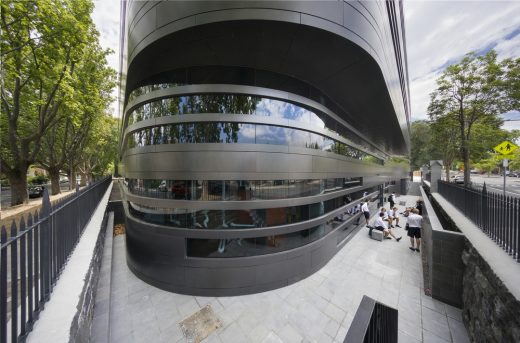
photograph : John Gollings
The Geoff Handbury Science and Technology Hub
Hexagone, Luminy University Campus
Design: Rémy Marciano Architecte
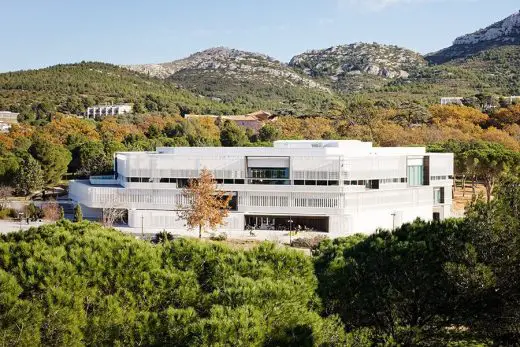
image Courtesy architecture office
Hexagone at Luminy University Campus in Marseille
, Mornington Peninsula, Victoria
Design: Jost Architects
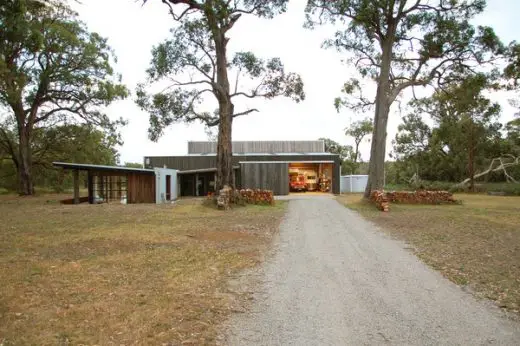
photograph : Patrick Jost
The Uber Shed
Nature Architecture : article by Trevor Tucker. 15 Sep 2009
Sustainable Buildings – Building Issues : article by Adrian Welch
Comments / photos for the Marcus Vitruvius Pollio – Architectural Origin Article page welcome

